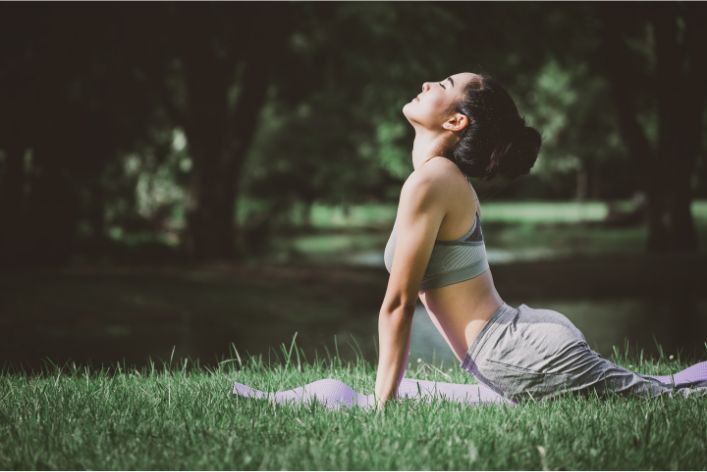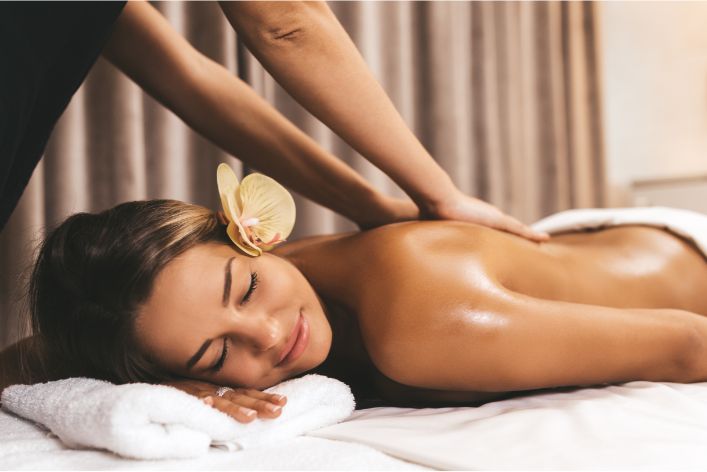Introduction
Definition of yoga and massage therapy
Let’s explore the connection between yoga and massage therapy.
Yoga and massage therapy are two different practices that have similarities that make them complementary.
Yoga is a mind-body practice that combines physical postures, breathing techniques, and meditation.
Massage therapy is the practice of manipulating soft tissues in the body to improve someone’s health and well-being.
The connection between the two practices lies in their aim to improve one’s physical, mental, and emotional state.
Statement of the connection between the two
The connection between yoga and massage therapy lies in their shared goal of promoting relaxation, reducing stress, and improving overall health.
Both practices involve techniques that calm the mind and body. Yoga’s physical postures help to relieve muscle tension and increase flexibility.
Moreover, its breathing exercises and meditation techniques promote relaxation and reduce stress.
Massage therapy, on the other hand, focuses on manipulating the soft tissues in the body to stimulate blood flow, relieve muscle tension, and reduce stress levels.
When practiced together, yoga and massage therapy create a holistic approach to wellness.
Yoga provides a mental and emotional foundation that prepares the body for massage therapy.
Massage therapy, in turn, helps the body to fully relax and calm the mind further.
Yoga and massage therapy have gained popularity in recent years due to their potential to improve one’s overall health and well-being.
Each practice offers unique benefits, but their shared goal makes them a perfect complement to each other.
Combining yoga and massage therapy brings together two practices that work together harmoniously to improve one’s mind, body, and spirit.
Enlisting the help of trained professionals in both fields can provide a great starting point for those interested in pursuing this holistic approach to wellness.
Benefits of Yoga and Massage Therapy
Yoga and massage therapy are two practices that have become increasingly popular for their physical and mental benefits.
Both practices work together to promote overall health and wellness, providing a holistic approach to healing.
Overview of the Health Benefits of Yoga and Massage Therapy
Yoga and massage therapy can help reduce stress, anxiety, and depression while enhancing overall physical health.
These practices help promote better sleep, lower blood pressure, and improve digestion.
Physical Benefits of Yoga and Massage Therapy
- Improved flexibility: Yoga helps increase flexibility, which can improve mobility and reduce the risk of injury.
- Improved circulation: Massage therapy helps increase blood flow, which can help reduce inflammation and promote healing.
- Improved posture: Both yoga and massage therapy can help improve posture, reducing pain and tension in the neck, shoulders, and back.
Mental Benefits of Yoga and Massage Therapy
- Stress relief: Yoga and massage therapy can help reduce stress, anxiety, and depression, promoting relaxation and a sense of well-being.
- Improved sleep: These practices can also improve sleep quality, helping individuals feel more rested and energized.
- Increased mindfulness: Yoga and massage therapy can promote mindfulness, helping individuals become more in-tune with their bodies and minds.
Yoga and massage therapy work together to promote wellness and can benefit individuals of all ages and abilities.
Whether used separately or in combination with each other, these practices can help individuals reduce stress and improve their physical and mental health.
Read: Yoga vs. Pilates: Which Is Right for You?

How yoga prepares the body for massage therapy
Yoga is known for its many benefits, and one of them is preparing the body for massage therapy.
By practicing certain yoga poses, a person can enhance their body’s flexibility and strength, leading to a more effective massage therapy experience.
Explanation of how certain yoga poses can help prepare the body for massage therapy
Yoga and massage therapy complement each other perfectly. By practicing yoga, one can prepare their body for the pressure and stretching involved in massage therapy.
Certain yoga poses help to open up the muscles and connective tissues, preparing them for deeper work during a massage session.
Yoga poses also help to increase the circulation of blood and oxygen throughout the body.
This results in a more relaxed and energized body, making it easier for the massage therapist to work on the muscles and tissues effectively.
Practicing yoga regularly can also help reduce stress levels and tension in the body, leading to an even more effective massage therapy experience.
Examples of yoga poses and their corresponding benefits for massage therapy
Here are some yoga poses that can help prepare the body for massage therapy:
- Downward Facing Dog: This pose helps stretch the whole body, including the hamstrings, back, and shoulders, which are often tight areas that can benefit from massage therapy. It also calms the mind and relieves stress.
- Cobra Pose: This backbend pose helps open up the chest and stretch the abdomen, preparing these areas for deeper work during massage therapy. It also strengthens the spine and stimulates the digestive organs.
- Child’s Pose: This pose helps to calm the mind and release tension in the shoulders and lower back. It also stretches the hips, thighs, and ankles, making them more pliable for massage therapy.
- Triangle Pose: This pose helps open up the hips and stretch the hamstrings, making it easier for the massage therapist to work on these areas. It also strengthens the legs and improves balance.
- Pigeon Pose: This pose stretches the hip flexors, which can be especially tight for people who sit for long periods of time. It also helps to release tension in the lower back and prepare the glutes for massage therapy.
By incorporating these yoga poses into your regular practice, you can enhance your massage therapy experience and reap the maximum benefits from the therapy session.
Remember to communicate with your massage therapist about your yoga practice and any areas that you would like them to focus on.
Yoga and massage therapy both have numerous benefits for the body and mind.
By combining these practices, you can achieve a deeper level of relaxation and a more effective therapy experience.
We Design & Develop Websites, Android & iOS Apps
Looking to transform your digital presence? We specialize in creating stunning websites and powerful mobile apps for Android and iOS. Let us bring your vision to life with innovative, tailored solutions!
Get Started TodaySo, whether you are a die-hard yogi or a massage therapy enthusiast, consider incorporating both practices into your routine for a healthy, happy body and mind.
Read: The Benefits of Yoga and How It Can Improve Your Health
How Massage Therapy Enhances a Yoga Practice
Yoga and massage therapy are two practices that are often utilized for their healing properties.
Both offer a range of physical and mental benefits, and when combined, they can enhance each other’s effectiveness.
In this section, we’ll explore how massage therapy can improve the effectiveness of a yoga practice, and discuss how it can help release tension and increase flexibility in the body.
Explanation of How Massage Therapy Can Improve the Effectiveness of Yoga Practice
Massage therapy and yoga share a common goal: to promote relaxation and healing in the body.
However, while yoga focuses on stretching and strengthening the muscles through movement and breath, massage therapy uses manual manipulation of the soft tissues to release tension and improve circulation.
Massage therapy can enhance the effectiveness of a yoga practice by prepping the body for the physical demands of yoga.
For example, if you have tight IT bands or hamstrings, a massage therapist can work to release that tension and help increase your range of motion before a yoga class.
By doing so, you’ll be able to go deeper into poses and stretch further than you would without having received the massage.
Additionally, the relaxation and stress-reducing benefits of massage therapy can help you enter a state of mind that is ideal for yoga.
When your mind is calm and focused, you’re better able to tune into your body and maintain the correct form during yoga poses.
By reducing muscle tension and nervous system activity through massage, your mind will be better equipped to fully engage in your yoga practice.
Discussion of How Massage Therapy Can Help Release Tension and Increase Flexibility in the Body
One of the primary benefits of massage therapy is its ability to release tension in the body.
When muscles are tight and tense, they can limit your range of motion and make it difficult to perform yoga poses correctly.
By breaking up knots and adhesions in the muscles, massage therapy can help increase flexibility and range of motion. This, in turn, can help you go deeper into yoga poses and achieve a greater stretch.
The effects of massage therapy can last long after your session, too.
With regular massage therapy, you can train your muscles to remain relaxed and flexible, even when you’re not actively stretching or practicing yoga.
This can help prevent future injuries and make it easier to perform yoga poses correctly and with ease.
Furthermore, massage therapy can help increase circulation throughout the body, which can aid in delivering oxygen and nutrients to the muscles.
This can enhance the body’s ability to recover after an intense yoga practice, and reduce soreness and stiffness in the muscles.
Massage therapy and yoga are both powerful modalities for promoting overall health and wellness.
By combining the two, you can enhance the effectiveness of your yoga practice and achieve a deeper sense of relaxation and healing in your body.
Whether you’re just starting with yoga or are a seasoned practitioner, consider incorporating massage therapy into your routine to maximize the benefits of your practice.
Read: Activewear As Everyday Fashion: The Rise of Athleisure

Different types of yoga and massage therapy
In the world of wellness, there are various types of yoga and massage therapy that can benefit the body in distinct ways.
These practices promote relaxation, increase flexibility, improve range of motion and enhance overall health and well-being.
Types of Yoga:
- Hatha Yoga: Hatha yoga is a gentle, slow-paced practice that focuses on breathing and stretching exercises. It is suitable for beginners and those seeking a more relaxing practice. Hatha yoga is beneficial for improving flexibility, balance, and relaxation.
- Vinyasa Yoga: Vinyasa yoga is a more dynamic practice that involves flowing movements and synchronizing breath with movement. It is a great way to improve cardiovascular health, build strength, and increase endurance. Vinyasa yoga is suitable for those who enjoy a more challenging practice.
- Bikram Yoga: Bikram yoga involves practicing yoga in a heated room, usually at a temperature of 105 degrees Fahrenheit. The classes are usually 90 minutes long and consist of a series of 26 postures and two breathing exercises. Bikram yoga is ideal for those who want to improve their endurance and performance and is great for detoxification and weight loss.
- Restorative Yoga: Restorative yoga is a very gentle and relaxing practice that seeks to promote deep relaxation and healing. It involves the use of props such as bolsters, blankets, and pillows to support the body in various poses. Restorative yoga is suitable for all levels and is beneficial for those with chronic pain or stress-related conditions.
Types of Massage Therapy:
- Swedish Massage: Swedish massage is the most common and widely known type of massage. It involves the use of long, smooth strokes, kneading and circular movements on the topmost layer of muscles. Swedish massage promotes relaxation, reduces stress and muscle tension, and provides overall wellness.
- Deep Tissue Massage: Deep tissue massage is a more intensive and therapeutic massage that involves applying deeper pressure on the muscles and connective tissues. This type of massage helps with pain relief, injury rehabilitation, and recovery, and improves posture and flexibility.
- Sports Massage: Sports massage is specifically designed for athletes or anyone involved in rigorous physical activity. It helps prevent injuries, prepares the body for strenuous activity, and promotes faster recovery after exercise. Sports massage involves stretching, deep tissue work, and muscle strengthening exercises.
- Thai Massage: Thai massage is a traditional form of massage that originated in Thailand. It combines yoga-like stretching, acupressure, and pressure point manipulation to improve flexibility, relieve muscle tension, and balance the body’s energy system.
Yoga and massage therapy are two practices that focus on the mind-body connection to promote wellness and relaxation. By incorporating these practices, you can improve your physical, mental, and emotional health.
Read: Why is Good Posture Crucial for Better Health?
Conclusion
Yoga and massage therapy are two practices that have been around for centuries and are known for their numerous health benefits.
Although they are different practices, they complement each other in various ways.
How Yoga and Massage Therapy are Connected
Both practices involve the manipulation of the body to produce a relaxing and rejuvenating effect.
Yoga uses stretching and bending of the body to promote increased flexibility, while massage therapy uses pressure and manipulation of the soft tissues to promote relaxation and relieve tension.
One of the most significant connections between the two practices is their emphasis on mindfulness.
Yoga and massage therapy require individuals to be present in the moment and focus on their breathing and body sensations.
We Design & Develop Websites, Android & iOS Apps
Looking to transform your digital presence? We specialize in creating stunning websites and powerful mobile apps for Android and iOS. Let us bring your vision to life with innovative, tailored solutions!
Get Started TodayThis mindfulness enhances the overall therapeutic effect of both practices.
The Benefits of Both Practices
Yoga is known for its many physical and mental benefits, including reducing stress and anxiety, improving flexibility and balance, and increasing mindfulness.
At the same time, massage therapy is known for reducing muscle tension, improving joint mobility, and promoting relaxation and stress relief.
When combined, the benefits of both practices are enhanced.
For instance, practicing yoga before a massage session can help relax the body and prepare it for the massage.
Similarly, practicing yoga after a massage therapy session can help maintain the relaxed state and promote continued mindfulness.
Final Thoughts on the Benefits of Both Practices
Yoga and massage therapy are two practices that complement each other in various ways. They both promote mindfulness, enhance relaxation, and improve overall wellness.
By incorporating both practices into their daily routine, individuals can enjoy a wide range of physical and mental benefits that promote a healthier lifestyle.
Before you go…
Hey, thank you for reading this blog to the end. I hope it was helpful. Let me tell you a little bit about Nicholas Idoko Technologies.
We help businesses and companies build an online presence by developing web, mobile, desktop, and blockchain applications.
We also help aspiring software developers and programmers learn the skills they need to have a successful career.
Take your first step to becoming a programming boss by joining our Learn To Code academy today!
Be sure to contact us if you need more information or have any questions! We are readily available.
Put Your Tech Company on the Map!
Get featured on Nicholas Idoko’s Blog for just $200. Showcase your business, boost credibility, and reach a growing audience eager for tech solutions.
Publish Now










